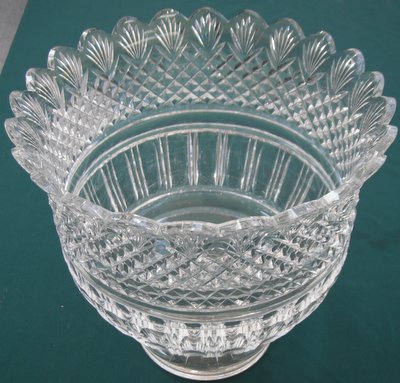
by Dr. Lori Verderame
Today, punch bowls are regularly found stored high above a kitchen’s countertop, among the silver in a butler’s pantry, or with the linens in an overstuffed Duncan Phyfe dining room sideboard. Dating back to the early 1600s in India, punch bowls were found in middle class households, church halls, mansions, pubs, and taverns alike. Punch bowls were owned by anyone who liked a party and one’s social status was noted by the number of different punch bowls that you owned. Punch is a catch all term for cool drinks made with fruit, a beer alternative. Move over beer steins, here comes the punch bowl.
History of Punch bowls
Punch bowls were produced in the traditional ceramic materials of the day–earthenware, porcelain, and ironstone–as evinced by the popular Chinese porcelain export trade. Punch bowls were on hand in the homes of our founding fathers including Benjamin Franklin, Thomas Jefferson, and Paul Revere to name a few. The patriot and silversmith, Revere made a silver punch bowl in the late 1760s that is now in the collection of the Museum of Fine Arts, Boston. Such serving pieces indicated an interest in showing one’s social status and hosting a community gathering using a punch bowl at its center.
Over time, punch bowls were produced in ceramic materials like flow blue, majolica, and porcelain by firms such as Meissen, Spode, and Wedgwood and those in Staffordshire and Limoges porcelains. Other punch bowls were made of hand cut glass like the Dorflinger punch bowl set worth nearly $150,000, pressed glass, and decorative glass like Depression glass and Mary Gregory glass and by famous firms like Lalique and Waterford.
What to Look For
Some of the most collectible punch bowls are made of glass. Examples range from punch bowls made abroad like the famous Venetian glass punch bowls by Murano with gilt or gold leaf details dating from the 1920s. From the United States, glass punch bowls run the gamut from pressed glass examples to American brilliant cut glass pieces made in regions like upstate New York, circa 1900-1920s to Tiffany style punch bowls of colorful iridescent–like early Roman glass–from the World War I era. Other glass punch bowls include Carnival glass examples made by Fenton with purple iridescence in the popular wreath of roses pattern or Ruby glass cut to clear punch bowls with matching handled drinking cups made by the National Glass Company. Such punch bowls often have two parts with a large round bowl sitting upon a pedestal or footed base.
Collect antique punch bowls and accessories in sets when you can including cups (up to as many as 24 cups in a set) and matching ladles.
Ceramic punch bowls often did double duty as compotes to hold either punch or fresh fruit. These bowls date from the late 19th Century, a.k.a. the Victorian period. Enamelware, moriage, majolica, and ceramic transferware in blue/white porcelain punch bowls were favorites in Italy, England, and France during the late 1800s. These punch bowls demonstrated highly recognizable patterns featuring pastoral landscape scenes, cute and chubby cherubs or putti, hand painted trees and leaves, Asian-inspired rose medallion decoration, and patterns in ceramic that are similar to the look of fabrics of floral chintz. These punch bowls like flow blue and other ceramic styles are produced by the major Staffordshire ceramic firms such as Wedgwood, Royal Doulton, etc.
Specialty punch bowls shows the guest the type of punch to be served by the host from their size, shape, or design. For instance, a small scale punch bowl tells guests that a heavy or rich punch will be served such as eggnog. Eggnog punch bowls are typically small in size and slender in form. The punch bowl’s size, in this case, also indicates the small amount of eggnog that a guest is expected to consume.
On the other hand, large punch bowls are typically reserved for fruit-based, non-alcoholic punches with large slices of fruit like pineapples swimming within the punch. These types of punches are served in big, round punch bowls at picnics and other casual, outdoor events.
Patterns and decorative elements on a punch bowl will further pinpoint the type of punch a certain punch bowl will hold. For instance, grape patterns on a glass punch bowl suggests a wine based punch within, hence the grape designs. And, champagne punch is almost always served in a see-thru glass punch bowl so guests can watch the bubbles within the punch.
Punch bowl market
Punch bowls aren’t just for entertaining anymore, as now these over sized and decorative catch-alls are beautiful and beneficial to any lively household. Interior designers, smart re-purposers, and DIYers are using old punch bowls as centerpieces on dining room tables filled with flowers or potpourri, on granite kitchen islands brimming with recipe cards, chip clips, and napkins, on bathroom floor tiles overflowing with towels, giant rose bowls, soaps, and lotions, and on fireplace hearths hosting long matchsticks, pinecones, etc.
Depending on various factors such as origin, maker, and condition, antique and vintage punch bowls can be extremely valuable and highly sought after. Examples regularly command prices starting at one thousand dollars on the antiques market and continuing upward from there.
In the antiques and collectibles market, punch bowls are all the rage, once again. As wedding antiques, punch bowls are among the most popular with today’s collectors and flea market bargain hunters.
Get an online appraisal report of your punch bowl from Dr. Lori.



